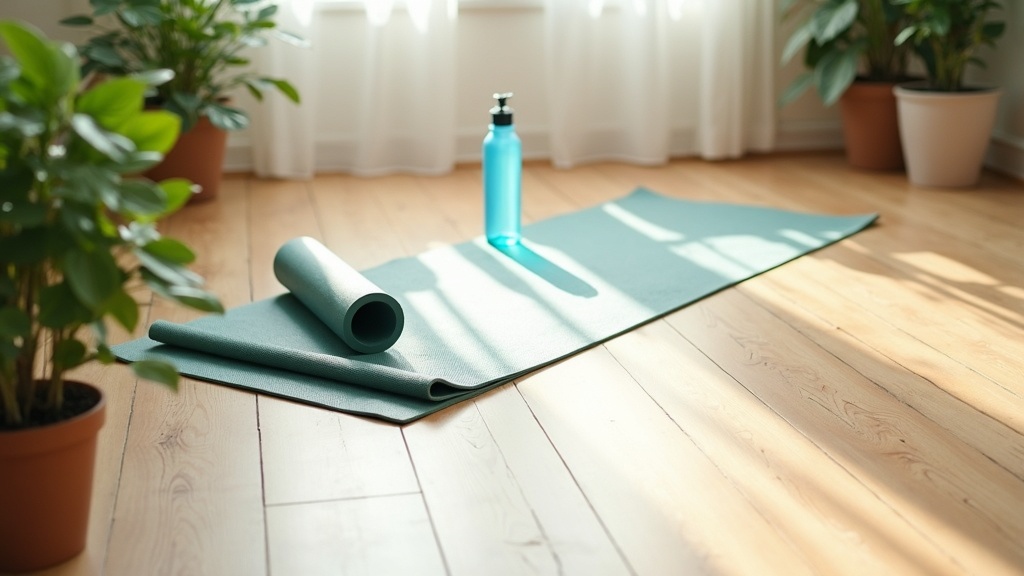 Soccer takes a lot out of your body, leaving players sore, tight, and sometimes feeling pretty drained after matches and training sessions. Recovery isn’t just about rest on the couch; active recovery, like soccer specific yoga routines, can be super useful. These routines ease muscle soreness, boost flexibility, and help you get back on the field feeling fresh and ready to go.
Soccer takes a lot out of your body, leaving players sore, tight, and sometimes feeling pretty drained after matches and training sessions. Recovery isn’t just about rest on the couch; active recovery, like soccer specific yoga routines, can be super useful. These routines ease muscle soreness, boost flexibility, and help you get back on the field feeling fresh and ready to go.
Even if you’re new to yoga or feel like you’re not flexible at all, adding a simple recovery routine to your week can make a real, noticeable difference. The best part is you don’t need fancy equipment; just a mat (or even a towel) and a little bit of space. I’ve found that adding some recovery yoga after matches, hard practices, or when you have a rest day helps keep cramps and muscle tightness away. So if you want fewer aches and faster bounce-back, this is worth checking out.
This guide covers the basics on why yoga works for soccer recovery, key routines and poses to try, adjustments if you’re hurting or super tight, and answers to some of the most common questions that players have. By the end, you’ll know exactly how to use yoga to recover stronger and stay ready for your next game. Missing Groß: Are we underestimating the impact of losing Der Kaiser?
byu/jerseyjoe1 inBrightonHoveAlbion
The Benefits of Yoga for Soccer Players
Players at every level are adding yoga to their recovery routine, and for a good reason. The physical demands of soccer – sprinting, dribbling, quick turns and stops – push your muscles hard. Here’s why yoga is a great tool for feeling better and recovering faster:
- Reduces Muscle Soreness: Gentle stretching and controlled breathing help flush out lactic acid and ease post-match tightness.
- Boosts Flexibility: Tight hamstrings, quads, and hips are common for soccer players. Yoga stretches out these areas, helping prevent injuries as you go.
- Improves Balance & Body Awareness: Yoga trains muscle control; this comes in handy for stability during tackles and quick changes in direction.
- Lowers Stress and Calms Nerves: Deep breathing and relaxation help the mind unwind, which is just as important after a tough match as physical recovery.
- Adds Range of Motion: Stretching your muscles through their full ranges means you move with fewer restrictions on the pitch.
Using yoga as a recovery tool helps you get the most out of time off the pitch. It speeds up recovery, so you can train harder when you get back out there. Plus, with regular practice, you might stumble upon more ease in movement and a sense of calm, both useful on and off the field.
How to Build a Soccer Recovery Yoga Routine
Building a recovery routine isn’t just about rolling out a mat and hoping for the best. It helps to break down your post-soccer yoga into four main parts: a gentle warmup, lower body recovery, upper body and back, and then short relaxation. It keeps things organized and makes sure nothing gets missed. Here’s a basic structure you can start with:
- Gentle Warmup (2-3 min)
Breathe deeply and move lightly to wake up stiff muscles. Cat-cow, gentle twists, or just a slow fullbody stretch work great here. - Lower Body Release (7-10 min)
Focus on stretching hamstrings, calves, quads, and hip flexors. These areas take the most beating from running and agility drills. - Upper Body & Back (4-5 min)
Open up your chest, shoulders, and back. Holding planks or child’s pose can relieve tension from sprinting and heading the ball. - Relaxation (2-5 min)
Lie flat and take slow, deep breaths. This helps your whole system wind down and signals recovery mode to your body.
You can adjust the timing if you’re short on time, but try to hit each section so nothing important is left out. Even 10 minutes is better than nothing at all.
Top Yoga Poses for Soccer Players
Lower Body Recovery Poses
- Downward Dog: Stretches calves, hamstrings, and your lower back; hold for 20-30 seconds.
- Low Lunge: Targets hip flexors and quads; sink into the hips and breathe steady for 20-30 seconds per side.
- Pigeon Pose: Opens up the glutes and outer hips, which is great for releasing post-game hip tension.
- Seated Forward Fold: Deep stretch for tight hamstrings. Go easy; there’s no need to bounce or force the stretch.
- Reclined Figure Four: Great for working out tightness in the hip and glute area; hold for 20-30 seconds on each side.
Upper Body and Back Stretches
- Child’s Pose: Relax the lower back and shoulders. It’s also a good reset between other poses.
- Cow Face Arms: Really opens up the shoulders, which can get crunched from defending and throw ins.
- Thread the Needle: Stretches the back and the sides of your body, especially after a game with lots of twists and turns.
Relaxation and Recovery
- Supine Twist: Eases the lower back and brings a gentle stretch after intense play.
- Savasana (Corpse Pose): Just lying still with your eyes closed helps finish things off and lets your nervous system chill out.
Pick a few from each list and mix them up based on what feels tight or sore. Flexibility and recovery improve most with consistency rather than variety alone.
Tips for Making Soccer Recovery Yoga Actually Work
- Hydrate First: Drink water before hitting the mat. Dehydration makes muscles stiff and cranky. Water also helps flush out toxins, keeping muscles happy.
- Go Slow: Push gently into stretches, never to pain. Muscles bounce back better when you give them time to respond instead of forcing things. Slow progress is still progress.
- Don’t Skip Breathwork: Big, slow inhales and exhales are key for recovery and for lowering your postgame anxiety. Try a count of four in, and four out, while holding every stretch.
- Keep It Consistent: Two to three recovery sessions per week is a good place to start. Right after practice or the morning after a match works well.
- Adapt to How You Feel: On really sore days, hold poses longer but skip the deep stretches. On lighter days, work on opening your range of motion and loosening up new spots.
It’s not about being perfect or super flexible; it’s about showing up, stretching, and letting your muscles recover at your own pace. Even a basic routine will give a boost to your soccer game if you stick with it.
Common Questions & Troubleshooting
What if I’m super tight or injured?
There are definitely days when even a gentle forward fold feels like too much. On those days, use props like rolled towels or yoga blocks for extra support, and back off on deep stretches. Avoid any moves that bring sharp pain. Sometimes, just spending time in child’s pose or a gentle supine twist is enough to help you feel better while letting your body rest.
Can I use these routines right after games, or should I wait?
Gentle yoga is generally safe right after games for most players. Avoid intense or tricky balances. Stick with easy, relaxing stretches that help the body calm down. If you’re completely wiped out, some light stretching and a good night’s sleep might do the trick until you’re ready for a longer session.
How long does a routine need to be?
Even 10-15 minutes can bring real benefits. It’s more about consistency than about the exact routine length. You can always add or skip a pose or two depending on your own schedule.
Your Recovery Yoga Game Plan
Any soccer player looking to cut down on soreness and get back in action faster will benefit from regular recovery yoga. I recommend making it a habit, even if you only have time for a few stretches after games or tough sessions. Here’s a quick way to put all this into action:
- Pick 3-5 of the poses listed above and hold each stretch for 20-30 seconds, repeating both sides as needed.
- Add a few minutes of relaxation at the end with slow breathing or lying flat on your back—no phone, no distractions. Let your body absorb the work you’ve put in and reset.
- Do this routine after training, after matches, or on recovery days two to three times a week. The more you keep up, the more benefits you’ll feel.
Give it a try and see how much lighter you feel heading into your next session. More flexibility, faster recovery, and less stiffness are all worth the small time investment. If you have a favorite stretch or yoga pose that helps after games, feel free to share it. Every player finds a move that works best for their own body. Start simple, stick with it, and check in with your body often. Consistent recovery routines can make all the difference for your play and overall health.
